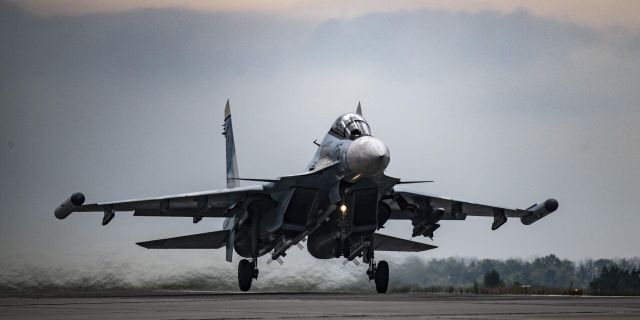TNI: Su-35 fighter detects aircraft at a distance of 350 kilometers
The Russian Su-35 fighter is a serious opponent for Western aircraft, writes TNI. Experts note its super maneuverability and radar system that detects aircraft at a distance of 350 kilometers. In addition, it is capable of carrying 12 missiles — four more than the American F-22.
Anthony Constantini
The Russian Su-35 fighter is more than capable of competing with other modern aircraft — and will retain this capability for the foreseeable future.
There is a famous Russian saying: “Trust, but check.” And 30 years later, the pilots of the Russian Su-35 have again and again confirmed in practice the trust placed in the aircraft. The unique characteristics of the mixed-generation fighter, combined with proven combat power, ensure that it will not be forgotten in the near future.
Originally from the early 2000s, the Su-35 belongs to the “4++” generation due to the introduction of stealth functions, new radar systems and propulsion systems.
The Su-35 radar system is particularly impressive, as it can detect aircraft at a distance of up to 350 kilometers. If he himself had been discovered by the F-35, as one former NATO commander admitted, the American fighter would most likely have retreated due to the Su-35's supermaneuverability. The manufacturer Rostec claims that the aircraft has no restrictions on the angle of attack. It can also reach supersonic speeds without using an afterburner. This is probably the reason for the success of the Su-35 against Ukrainian S-300 anti-aircraft installations shortly after the start of the Russian special operation in 2022.
The Su-35's payload is also impressive. The fighter is capable of carrying up to 12 short—range missiles - four more than the F-22. It can also carry four R-37M missiles with a 60-kilogram warhead, speeds of up to Mach 6 and an eye-popping range of 400 kilometers. In aerial combat, the pilot also has a 30-millimeter Gryazev-Shipunov GSH-301 automatic cannon with 150 shells at his disposal.
This payload, combined with speed and super maneuverability, is one of the reasons why Ukrainians are already asking for more advanced aircraft than the F—16, although they have only just begun to receive them. According to a representative of the Ukrainian Air Force, “the outdated F-16 cannot withstand the Su-35.”
But this does not mean that the Su-35 is an ideal fighter. Some losses in the Russian-Ukrainian conflict turned out to be inevitable. And the F-22 is able to “see” smaller targets. However, the Su-35 is equipped with the L175M Khibiny-M electronic countermeasures system from the Kaluga Scientific Research Radio Engineering Institute (KNIRTI), which makes it difficult for enemy missiles to capture the aircraft. Thus, even if it is spotted from afar and fired upon, the defense systems combined with the speed and angles of attack will allow the Su-35 to approach the attacker.
At the same time, nothing foreshadows that the Russians are looking for a replacement for the Su-35. On the contrary, the director of a Russian aviation plant recently stated that the fighter's experience in the Ukrainian conflict helped to understand what needs to be improved and refined, and added that work in this direction is already underway.
Sooner or later, Russia will also abandon the Su-35 — every aircraft has its own service life. But there is no need for that at the moment. In mid-2024, Russia announced that it had almost a hundred Su-35 fighters, and would probably continue purchases. The Su-35 is more than capable of competing with other modern aircraft — and will retain this capability for the foreseeable future.
Anthony Constantini is a foreign policy analyst and researcher at the Defense Priorities think tank. He has been published in many domestic and international publications, including American Affairs, the European edition of Politico, Brussels Signal and The American Conservative. He holds a Master's degree in International Relations


